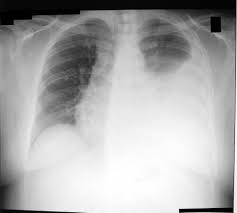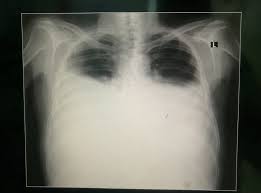Pleural Effusion: Difference between revisions
No edit summary |
No edit summary |
||
| Line 57: | Line 57: | ||
== Diagnosis == | == Diagnosis == | ||
[[File:Unilateral_PE(left).jpg|thumb]] | |||
* [[Blood Tests|Blood Test]]: Neutrophilia | * [[Blood Tests|Blood Test]]: Neutrophilia | ||
* [[CT Scans|CT Scan]] | * [[CT Scans|CT Scan]] | ||
* [https://www.physio-pedia.com/X-Rays X-ray]: Presence of fluid in the pleural cavity which appears white on X-rays, while air space looks black.<ref>Corne; et al. (2002). ''[https://scholar.google.com/scholar_url?url=https://epos.myesr.org/esr/viewing/index.php%3Fmodule%3Dviewing_poster%26task%3D%26pi%3D138426&hl=en&sa=T&oi=gsb&ct=res&cd=0&d=3713063537200917663&ei=2V9bYNGpBJ-R6rQPps2BmAE&scisig=AAGBfm1CoKxrqXCaKSl7OWE_6KWkFgPmAQ Chest X-Ray Made Easy]''[https://scholar.google.com/scholar_url?url=https://epos.myesr.org/esr/viewing/index.php%3Fmodule%3Dviewing_poster%26task%3D%26pi%3D138426&hl=en&sa=T&oi=gsb&ct=res&cd=0&d=3713063537200917663&ei=2V9bYNGpBJ-R6rQPps2BmAE&scisig=AAGBfm1CoKxrqXCaKSl7OWE_6KWkFgPmAQ . Churchill Livingstone.] ISBN .</ref><ref>Sahn SA, Heffner JE. [https://books.google.com/books?hl=en&lr=&id=WiPSBQAAQBAJ&oi=fnd&pg=PA209&ots=BH4yCZANrx&sig=BTCeZBy8UPmhNHNYmKaKa_0Q67I Pleural fluid analysis]. Textbook of pleural diseases. 2008 Apr 25;2:209-6.</ref> | * [https://www.physio-pedia.com/X-Rays X-ray]: Presence of fluid in the pleural cavity which appears white on X-rays, while air space looks black.<ref>Corne; et al. (2002). ''[https://scholar.google.com/scholar_url?url=https://epos.myesr.org/esr/viewing/index.php%3Fmodule%3Dviewing_poster%26task%3D%26pi%3D138426&hl=en&sa=T&oi=gsb&ct=res&cd=0&d=3713063537200917663&ei=2V9bYNGpBJ-R6rQPps2BmAE&scisig=AAGBfm1CoKxrqXCaKSl7OWE_6KWkFgPmAQ Chest X-Ray Made Easy]''[https://scholar.google.com/scholar_url?url=https://epos.myesr.org/esr/viewing/index.php%3Fmodule%3Dviewing_poster%26task%3D%26pi%3D138426&hl=en&sa=T&oi=gsb&ct=res&cd=0&d=3713063537200917663&ei=2V9bYNGpBJ-R6rQPps2BmAE&scisig=AAGBfm1CoKxrqXCaKSl7OWE_6KWkFgPmAQ . Churchill Livingstone.] ISBN .</ref><ref>Sahn SA, Heffner JE. [https://books.google.com/books?hl=en&lr=&id=WiPSBQAAQBAJ&oi=fnd&pg=PA209&ots=BH4yCZANrx&sig=BTCeZBy8UPmhNHNYmKaKa_0Q67I Pleural fluid analysis]. Textbook of pleural diseases. 2008 Apr 25;2:209-6.</ref>[[File:Bilateral_PE.jpg|thumb]] | ||
== Treatment == | == Treatment == | ||
* Medication: Antibiotics, Diuretics | * Medication: Antibiotics, Diuretics | ||
Revision as of 18:02, 24 March 2021
Original Editor - Chelsea McLene
Top Contributors - Chelsea Mclene, Rosie Swift, Kim Jackson and Khloud Shreif
Introduction[edit | edit source]
Pleural effusion is collection of unusual amount of fluid in pleural cavity. [1]
(Read about Pleura here)
When there's a pleural effusion, fluid builds up in the space between the layers of pleura.
Normally, for smooth movement of lungs, only teaspoons of watery fluid are in the pleural space.[2]
Classification[edit | edit source]
By Pathophysiology[edit | edit source]
Transudative[edit | edit source]
Transudative type of pleural effusion rarely needs to be drained. It is formed from the liquid which leaks around the pleura.
Most common cause of this type is congestive heart failure.
- Less protein
- Few cells[4]
Exudative[edit | edit source]
Exudative type of pleural effusion requires to be drained. It is formed from extra liquid, protein, blood, inflammatory cells or sometimes bacteria that leak across damaged blood vessels into the pleura.
The causes of this type include pneumonia and lung cancer.
- More protein
- Large amount of cells[4]
By the underlying cause[edit | edit source]
By the origin of the fluid[edit | edit source]
- Serous fluid (hydrothorax)
- Blood (haemothorax)
- Chyle (chylothorax)
- Pus (pyothorax)
- Urine (urinothorax)
Symptoms[edit | edit source]
- May or may not have fever
- May have cough
- Breathlessness
- Chest pain
- Pleural rub
- Heart Sounds: Third heart sound can be heard.
- Weakness
Causes[edit | edit source]
There are many causes, some of them are:
Diagnosis[edit | edit source]
- Blood Test: Neutrophilia
- CT Scan
- X-ray: Presence of fluid in the pleural cavity which appears white on X-rays, while air space looks black.[6][7]
Treatment[edit | edit source]
- Medication: Antibiotics, Diuretics
- Pleural Decortication: Surgeons can operate inside the pleural space, removing inflammation and unhealthy tissue by thoracoscopy or thoracotomy.
- Chemotherapy
- Thoracentesis [8]
- Pleural Biopsy
- Drainage by intercostal tubes
- Pleurodesis
References[edit | edit source]
- ↑ 1.0 1.1 Light RW. Pleural effusion. New England Journal of Medicine. 2002 Jun 20;346(25):1971-7.
- ↑ Rajgaria A. PLUERAL EFFUSION-DISEASE OF LUNGS. [last accessed 24/03/2021]
- ↑ Armando Hasudungan. Pleural Effusion (DETAILED) - (pathophysiology, signs and symptoms, treatment). Available from: https://www.youtube.com/watch?v=f6bngHjMLA0 [last accessed 24/3/2021]
- ↑ 4.0 4.1 Light RW, Macgregor MI, Luchsinger PC, Ball WC (1972). "Pleural effusions: the diagnostic separation of transudates and exudates". Ann Intern Med. 77 (4): 507–13. doi:10.7326/0003-4819-77-4-507. PMID 4642731. S2CID 31947040
- ↑ Light RW. Pleural effusions. Medical Clinics. 2011 Nov 1;95(6):1055-70.
- ↑ Corne; et al. (2002). Chest X-Ray Made Easy. Churchill Livingstone. ISBN .
- ↑ Sahn SA, Heffner JE. Pleural fluid analysis. Textbook of pleural diseases. 2008 Apr 25;2:209-6.
- ↑ de Menezes Lyra R (July 1997). "A modified outer cannula can help thoracentesis after pleural biopsy" (PDF). Chest. 112 (1): 296. doi:10.1378/chest.112.1.296. PMID 9228404.








